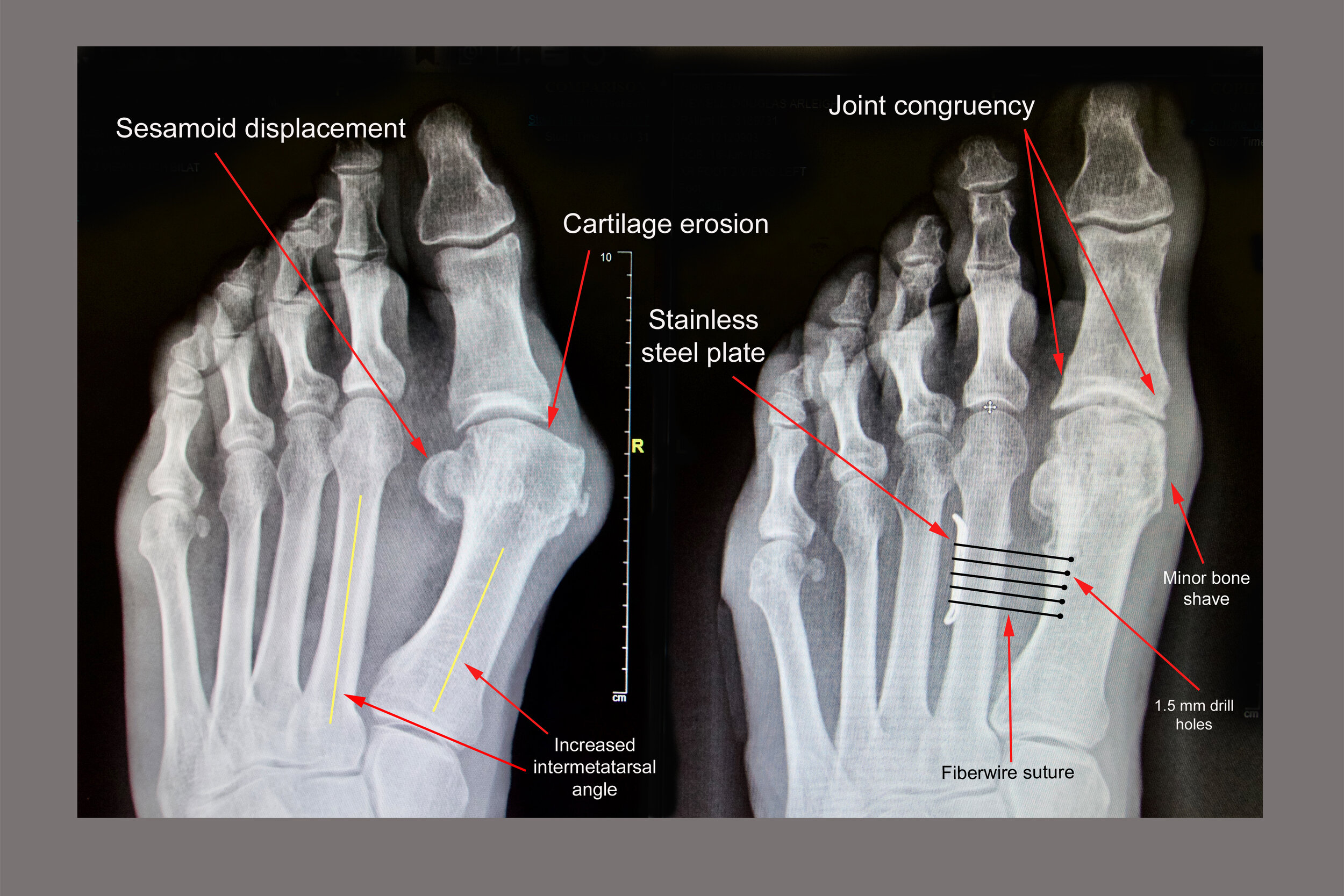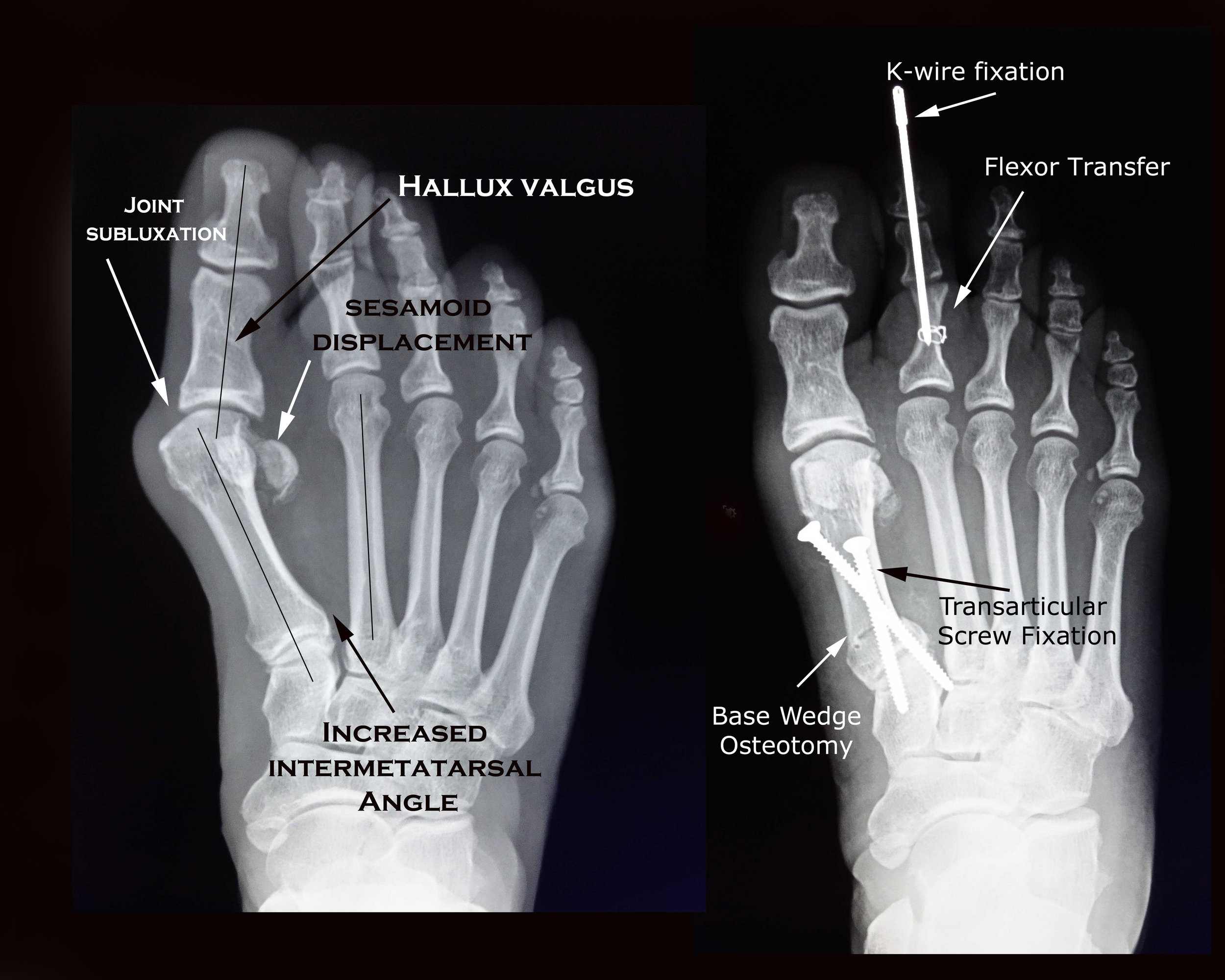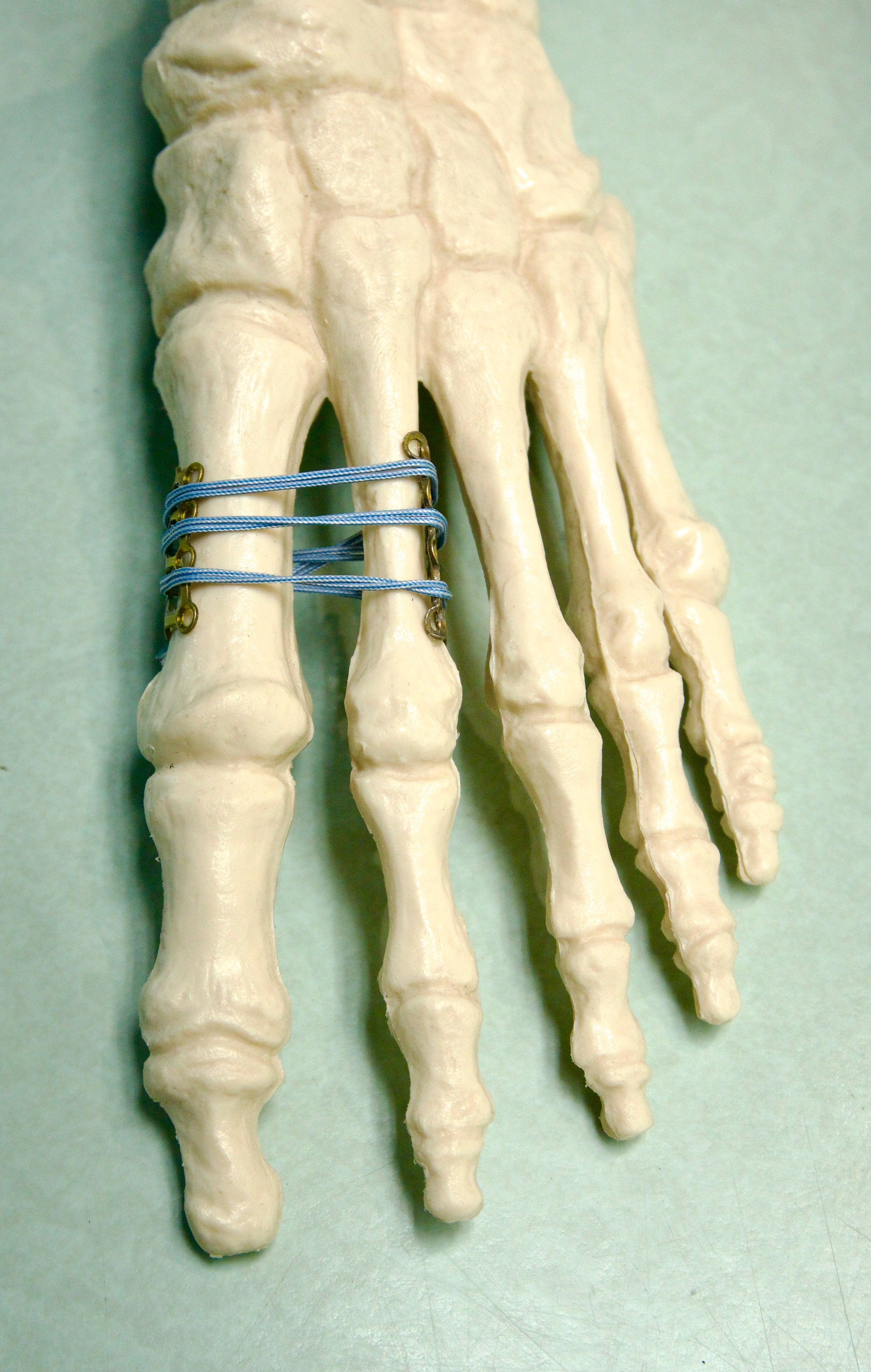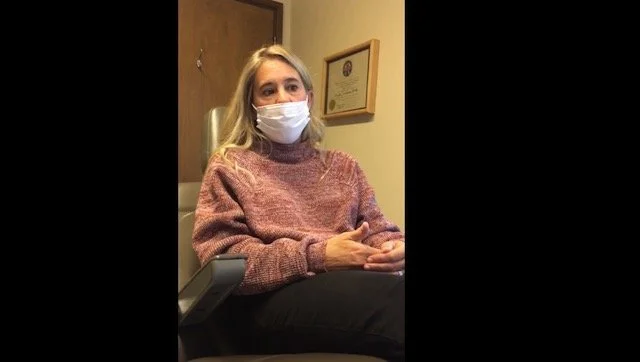The syndesmosis bunionectomy: a less traumatic procedure for bunion correction that eliminates the need for bone cutting or joint fusion.
The syndesmosis bunionectomy
In January of 2017, Dr. Doug and his daughter Molly (also a podiatric surgeon) traveled to Hong Kong to visit Daniel Wu, a Canadian trained orthopedic surgeon. Dr. Wu has been performing a unique bunionectomy surgery for over 20 years, and while his results are remarkable, the procedure has never really taken off in the United States. What Dr. Doug witnessed was truly remarkable: postoperative bunionectomy patients, who had both feet operated on, were walking into Dr. Wu's office two weeks after surgery for their first postop visit! Dr. Doug observed firsthand the surgery and follow up of severe bunions with this technique.
In 2017, Dr. Doug Ichikawa and his daughter, Dr. Molly Ichikawa, traveled to Hong Kong to visit Daniel Wu, M.D. and learn his syndesmosis procedure.
Dr. Wu's procedure is a 'syndesmosis bunionectomy' that does not require cutting or breaking the bone, unlike almost all other bunionectomy procedures. The metatarsal deformity is manually realigned and held in place with ultra high strength suture while the formation of a ‘new’ ligament between the metatarsals is facilitated with special 'fishscaling' techniques of the adjacent metatarsals and application of platelet rich fibrin. While walking is permitted from day one, it is necessary to avoid too much walking. There is a maximum # of steps per day that are allowed and a reduced rate of walking which are crucial for healing. It is 4-6 months before running or brisk walking for fitness can be done.
This bunionectomy technique not only corrects the deformity with less surgical trauma, but returns the foot back to its 'anatomically normal' form in ways no other procedure involving bone cuts or fusions can.
Dr. Ichikawa began early trials of this surgery on select patients beginning in 2017. It is his hope that this will quickly replace the traditional 'bone cutting' surgeries that are popular today.
Currently there is only one other surgeon worldwide performing this procedure, Dr. Dieter Fellner, in New York City.
Click the black box below to visit Daniel Wu, MD's website from Hong Kong featuring the syndesmosis procedure.
Contact Dr. Ichikawa: If you are a potential patient or a foot/ankle surgeon and are interested in learning more about this procedure, please email him at his university email: djichi@uw.edu. Patients who have had the surgery should be contacting him through his secure portal on this website or the ecare messaging system through the University of Washington. That way all conversations will be charted.
The Syndesmosis Bunionectomy with realignment without the need for bone cuts or screws.
Here is a typical xray before and after surgery.
Traditional bunion surgery with an angulated and shifted bone cut and screws.
This is an example of ‘traditional’ bunionectomy surgery that employs the use of an ‘osteotomy’ or bone cut to angulate the first metatarsal and screws that maintain that position until bone healing occurs. Note that a second toe surgery was included in this procedure. Note that the 1st metatarsal is shortened by this procedure!
Clinical foot appearance before, one month after and two months after the syndesmosis bunionectomy.
Why is the syndesmosis bunionectomy superior to other procedures?
It’s natural:
The syndesmosis bunionectomy is the the only procedure for bunion reduction that will give true 'anatomical' or naturally correct orientation and length to all the metatarsals. With other procedures, the 1st metatarsal and sometimes 2nd metatarsal are cut, realigned and fixated in the new position with hardware. This will often shorten the bone and place increased pressure on adjacent metatarsals
It’s kinder and gentler:
Without the cutting of bone or fusing of joints, the pain and inflammation from this procedure are significantly reduced. Patients with experience in both have said it is about 1/4 the pain and inflammation of a bone cut surgery. The recovery will allow for immediate weight bearing, but overall waiting for brisk walking and running is still long!
Long term study:
This procedure has been extensively studied by Dr. Daniel Wu, including 5 year followups, all with very good results. His studies are reference at the bottom of this page.
Bilateral (both feet) surgery is possible:
Since weight can be put on the surgical foot immediately afterwards, it is possible (although a bit of work!) to have both feet done at the same time. There is huge savings in medical and time off work costs associated with this. There is a nice photo essay on a patient’s journey through bilateral bunion surgery at the bottom of this page.
No osteotomy (bone cutting) complications:
While not common, complications in the bone healing process can happen anytime the bone is cut or a joint is fused. This sometimes means more time in a boot or on crutches and occasionally another surgery with bone grafting. This cannot happen with the syndesmosis bunionectomy.
Less expensive:
The syndesmosis bunionectomy is charged out at a lower fee since a bone cut is not necessary. There are no plates or jigs from surgical companies that the hospitals, surgery centers, and sometimes patients will have to absorb. Many of the plate systems alone will cost upwards of $1000.
Why are so few surgeons doing this procedure now?
Right now, there are only 3 surgeons doing this exact procedure. Many others may be doing something similar. The questions is why?
The learning curve for this procedure is steep: There have been more than one surgeon, well trained in conventional surgery that has tried and abandoned this technique. Early failures have probably ushered them away from this bunionectomy.
It is a highly technical and time consuming surgery, taking up to twice as long as a typical bone cutting procedure. This is due to the exact placement of sutures and delicate work to release the big toe joint in an appropriate fashion.
It was never incorporated into the residency training for foot surgeons who have for years relied on bone cuts for bunion correction.
There is no medical corporation behind it. Because of the lack of a proprietary plate or piece of hardware, the marketing incentive is not present.
Surgeons can only charge 1/2 to 1/3 the surgical fees for this because it doesn’t require a bone cut.
Click on the box below to go to Daniel Wu, MD’s website from Hong Kong.
Below is an informative video made by Daniel Wu, orthopedic surgeon from Hong Kong.
Sawbone foot model with Fiberwire suture and Synthes titanium strut plates.
Here is a foot model showing the Fiberwire suture and titatnium buffer plates. Notice that they are not drilled into the bone and only held in place by the suture. All hardware can be removed after one year.
The Biomet GPS or Arthrex ACP systems will harvest platelet rich plasma from a blood draw done while you’re under anesthesia. This will be treated with Thrombin to make a ‘platelet rich booger’ that is placed between the 1st and 2nd metatarsals to encourage synthesis of a ‘syndesmosis’ or intermetatarsal ligament for permanent maintenance of the IM angle correction.
Is the syndesmosis bunion procedure for you?
While the syndesmosis bunionectomy procedure allows both feet to be done at one time and allows for immediate walking, certain restrictions will be placed on the patient's walking for 6 months. If these restrictions are ignored, then complications like stress fractures of the metatarsals or recurrence of the bunion will occur. This procedure requires strict adherence to postop protocols.
You will be required to have a Fitbit or activity tracker to help you limit your walking after surgery.
A post-op shoe will be needed for 6 weeks, then a firm athletic shoe will do.
How much walking is allowed after this surgery?
50 steps per day for the first 3 days
500 steps per day for the rest of the 1st week
1000 steps per day after one week
2000 steps per day after two weeks
3000 steps per day after one months
4000 steps per day after two months
5000 steps per day after three months and this increases by 10% each week after that.
After 5 months you can walk 10,000 step per day in good athletic shoes.
After six months there are no restrictions with shoegear or activity.
Below is a video comparing the Syndesmosis Bunionectomy with the Lapiplasty:
Lapidus vs Syndesmosis Bunionectomies: Below is a video interview with a patient who has had both, one on each foot.
The following video compares the syndesmosis bunionectomy with other common bunion surgeries being performed today.
A note for out of state/out of country patients:
click the button below
Click below to read about Eva’s cross county adventure from Florida to have bilateral syndesmosis bunionectomies in Bellevue, Washington.



















